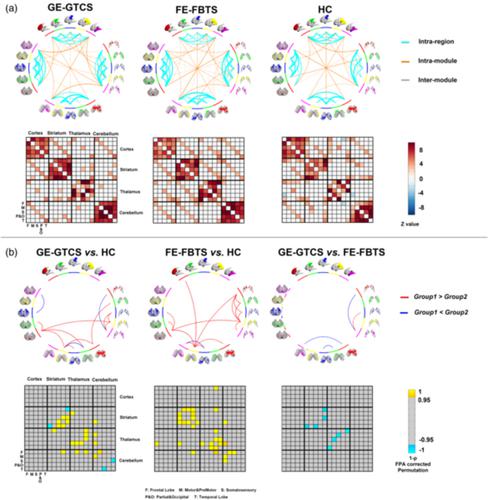当前位置:
X-MOL 学术
›
Hum. Brain Mapp.
›
论文详情
Our official English website, www.x-mol.net, welcomes your
feedback! (Note: you will need to create a separate account there.)
Cortico‐striato‐thalamo‐cerebellar networks of structural covariance underlying different epilepsy syndromes associated with generalized tonic–clonic seizures
Human Brain Mapping ( IF 3.5 ) Pub Date : 2020-12-29 , DOI: 10.1002/hbm.25279 Qiang Xu 1, 2 , Qirui Zhang 1 , Fang Yang 3 , Yifei Weng 1, 4 , Xinyu Xie 1 , Jingru Hao 1 , Rongfeng Qi 1 , Valentina Gumenyuk 5 , Steven M Stufflebeam 5 , Boris C Bernhardt 4 , Guangming Lu 1, 2, 6 , Zhiqiang Zhang 1, 5, 6
Human Brain Mapping ( IF 3.5 ) Pub Date : 2020-12-29 , DOI: 10.1002/hbm.25279 Qiang Xu 1, 2 , Qirui Zhang 1 , Fang Yang 3 , Yifei Weng 1, 4 , Xinyu Xie 1 , Jingru Hao 1 , Rongfeng Qi 1 , Valentina Gumenyuk 5 , Steven M Stufflebeam 5 , Boris C Bernhardt 4 , Guangming Lu 1, 2, 6 , Zhiqiang Zhang 1, 5, 6
Affiliation

|
Generalized tonic–clonic seizures (GTCS) are the severest and most remarkable clinical expressions of human epilepsy. Cortical, subcortical, and cerebellar structures, organized with different network patterns, underlying the pathophysiological substrates of genetic associated epilepsy with GTCS (GE‐GTCS) and focal epilepsy associated with focal to bilateral tonic–clonic seizure (FE‐FBTS). Structural covariance analysis can delineate the features of epilepsy network related with long‐term effects from seizure. Morphometric MRI data of 111 patients with GE‐GTCS, 111 patients with FE‐FBTS and 111 healthy controls were studied. Cortico‐striato‐thalao‐cerebellar networks of structural covariance within the gray matter were constructed using a Winner‐take‐all strategy with five cortical parcellations. Comparisons of structural covariance networks were conducted using permutation tests, and module effects of disease duration on networks were conducted using GLM model. Both patient groups showed increased connectivity of structural covariance relative to controls, mainly within the striatum and thalamus, and mostly correlated with the frontal, motor, and somatosensory cortices. Connectivity changes increased as a function of epilepsy durations. FE‐FBTS showed more intensive and extensive gray matter changes with volumetric loss and connectivity increment than GE‐GTCS. Our findings implicated cortico‐striato‐thalamo‐cerebellar network changes at a large temporal scale in GTCS, with FE‐FBTS showing more severe network disruption. The study contributed novel imaging evidence for understanding the different epilepsy syndromes associated with generalized seizures.
中文翻译:

与全身强直-阵挛发作相关的不同癫痫综合征的结构协方差的皮质-纹状体-丘脑-小脑网络
全身性强直-阵挛发作 (GTCS) 是人类癫痫最严重和最显着的临床表现。皮质、皮质下和小脑结构,以不同的网络模式组织,是遗传相关性癫痫伴 GTCS (GE-GTCS) 和局灶性癫痫伴双侧强直阵挛发作 (FE-FBTS) 的病理生理学基础。结构协方差分析可以描述与癫痫发作的长期影响相关的癫痫网络特征。研究了 111 名 GE-GTCS 患者、111 名 FE-FBTS 患者和 111 名健康对照者的形态学 MRI 数据。使用具有五个皮质分区的赢家通吃策略构建了灰质内结构协方差的皮质-纹状体-丘脑-小脑网络。结构协方差网络的比较使用置换检验进行,疾病持续时间对网络的模块效应使用GLM模型进行。与对照组相比,两个患者组的结构协方差连接性增加,主要在纹状体和丘脑内,并且主要与额叶、运动和体感皮层相关。连接性变化随着癫痫病程的增加而增加。FE-FBTS 显示出比 GE-GTCS 更密集和更广泛的灰质变化,体积损失和连通性增加。我们的研究结果表明,在 GTCS 中,皮质-纹状体-丘脑-小脑网络在大时间尺度上发生了变化,其中 FE-FBTS 显示出更严重的网络中断。
更新日期:2021-02-03
中文翻译:

与全身强直-阵挛发作相关的不同癫痫综合征的结构协方差的皮质-纹状体-丘脑-小脑网络
全身性强直-阵挛发作 (GTCS) 是人类癫痫最严重和最显着的临床表现。皮质、皮质下和小脑结构,以不同的网络模式组织,是遗传相关性癫痫伴 GTCS (GE-GTCS) 和局灶性癫痫伴双侧强直阵挛发作 (FE-FBTS) 的病理生理学基础。结构协方差分析可以描述与癫痫发作的长期影响相关的癫痫网络特征。研究了 111 名 GE-GTCS 患者、111 名 FE-FBTS 患者和 111 名健康对照者的形态学 MRI 数据。使用具有五个皮质分区的赢家通吃策略构建了灰质内结构协方差的皮质-纹状体-丘脑-小脑网络。结构协方差网络的比较使用置换检验进行,疾病持续时间对网络的模块效应使用GLM模型进行。与对照组相比,两个患者组的结构协方差连接性增加,主要在纹状体和丘脑内,并且主要与额叶、运动和体感皮层相关。连接性变化随着癫痫病程的增加而增加。FE-FBTS 显示出比 GE-GTCS 更密集和更广泛的灰质变化,体积损失和连通性增加。我们的研究结果表明,在 GTCS 中,皮质-纹状体-丘脑-小脑网络在大时间尺度上发生了变化,其中 FE-FBTS 显示出更严重的网络中断。











































 京公网安备 11010802027423号
京公网安备 11010802027423号